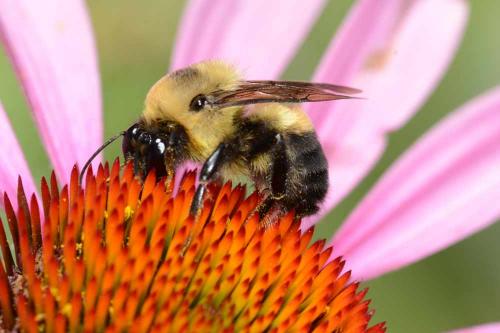Bumblebees

The Bumblebee can be either; black and yellow or black and orange, with an overall fuzzy appearance. These bees don't usually nest in structures, although we have found them in subareas and attics in the insulation. They are mostly around flowers collecting the nectar. They fly at 7 to 12 mph and will travel at least 3 miles from their nest to locate nectar.
The Bumblebee will establish its nest in the ground, often in an abandoned mouse nest. Her nest is a dark cavity containing fine plant fiber. Her nest is either a subterranean cavity or a surface grass clump. She will then create a honey pot of wax scales near the nest entrance into which she regurgitates nectar. On her nest floor she will make a pollen clump and lay 8 to 10 eggs on it. She will continue over time to add pollen and nectar to the clump and deposit more eggs. It takes 16 to 25 days for the egg to develop into an adult with the life expectancy of 2 weeks. Due to parasitism, there will be 50% of the workers eliminated weekly. The size of a mature nest will be anywhere from 50 to 400 bees. The temperature within the nest is about 86 F. This is accomplished by something called thermoregulation, in which the bee relaxes the third auxiliary muscle to its wings, which unhinges the wings from the main power-producing thoracic muscles. Body heat is produced by the contractions of these large muscles without wing movement.
When out foraging for nectar, the Bumblebee can be out in temperature below 50 F due to their ability to warm up their flight muscles by thermoregulation, as we have just described. Most bees need the temperature to be above 61 F. They will store their pollen and nectar in old cocoons. To protect their nest from being raided by other animals such as skunks and foxes they never store more than a few days worth of their food.
There are two species of Bumblebees, Psithyrus and Bombus. The Psithyurus queens are parasitic on Bombus nests. She will wait for the Bombus nest to get to a moderate size, enter the nest, kill the Bombus queen and take over the nest. She will use the Bombus workers to care for her young.
Only inseminated queens overwinter. The remainder of the nest will die with the onset of the cold temperatures; which includes the males, workers, the old queen and virgin new queens.
For further information, click on the link below.
Courtesy of Washington State University Extension




 Follow
Follow

